
7
C) Fire and explosion prevention
Causes of fire and explosion are:
1) combustibles reached by the arc, flame, flying sparks, hot slag or heated
material;
2) misuse of compressed gases and cylinders;
3) short circuits.
BE AWARE THAT flying sparks or falling slag can pass through cracks, along pipes,
through windows or doors, and through wall or floor openings, out of sight of the
goggled operator. Sparks and slag can fly 10M.
To prevent fires and explosion: keep equipment clean and operable, free of oil,
grease, and (in electrical parts) of metallic particles that can cause short circuits.
If combustibles are in area, do NOT weld or cut. Move the work if practicable, to
an area free of combustibles.
Avoid paint spray rooms, dip tanks, storage areas, ventilators. If the work cannot
be moved, move combustibles at least 10M away out of reach of sparks and
heat; or protect against ignition with suitable and snug fitting, fire- resistant covers
or shields.
Walls touching combustibles on opposite sides should not be welded on (or cut).
Walls, ceilings, and floor near work should be protected by heat resistant covers
or shields. Fire watcher must be standing by with suitable fire extinguishing
equipment during and for some time after welding or cutting if:
a) appreciable combustibles (including building construction) are within 10m.
b) appreciable combustibles are further than 10m but can be ignited by sparks.
c) openings (concealed or visible) in floors or walls within 10m can expose
combustibles to sparks.
d) combustibles adjacent to walls, ceilings, roofs or metal partitions can be
ignited by radiant or conducted heat.
After work is done, check that area is free of sparks, glowing embers, and flames.
An empty container that held combustibles, or that can produce flammable or
toxic vapours when heated, must never be welded on or cut, unless container
has first been cleaned. This includes a thorough steam or caustic cleaning (or a
solvent or water washing, depending on the combustible’s solubility) followed by
purging and inerting with nitrogen or carbon dioxide, and using protective
equipment.
Water filling just below working level may substitute for inerting.
A container with unknown contents should be cleaned (see paragraph above),
do NOT depend on sense of smell or sight to determine if it is safe to weld or cut.
Hollow castings or containers must be vented before welding or cutting - they
can explode.
In explosive atmospheres, never weld or cut where the air may contain flammable
dust, gas, or liquid vapours.
10
2) Electrode holders
Fully insulated electrode holders should be used. Do NOT use holders with
protruding screws or with any form of damage.
3) Connectors
Fully insulated lock-type connectors should be used to join welding cable.
4) Cables
Frequently inspect cables for wear, cracks and damage. IMMEDIATELY
REPLACE those with excessively worn or damaged insulation to avoid
possibly lethal shock from bared cable. Cables with damaged areas may
be taped to give resistance equivalent to original cable. Keep cable dry,
free of oil and grease, and protected from hot metal and sparks.
5) Terminals and other exposed parts
Terminals and other exposed parts of electrical units should have insulating
covers secured before operation.
6) Electrode
a) Equipment with output on/off control (contactor)
Welding power sources for use with the gas metal arc welding, gas
tungsten arc welding and similar processes normally are equipped with
devices hat permit on/off control of the welding power output. When
so equipped the electrode wire becomes electrically LIVE when the
power source switch is ON and welding gun switch is closed. Never
touch the electrode wire or any conducting object in contact with
the electrode circuit unless the welding power source is off.
b) Equipment without output on/off control (no contactor)
Welding power sources used with shielded metal arc welding and similar
processes may not be equipped with welding power output on/off
control devices. With such equipment the electrode is electrically LIVE
when the power switch is turned ON. Never touch the electrode unless
the welding power source is off.
7) Safety devices
Safety devices such as interlocks and circuit breakers should not be
disconnected or shunted out. Before installation, inspection, or service of
equipment, shut OFF all power and remove line fuses (or lock or red-tag
switches) to prevent accidental turning ON of power. Do not open power
circuit or change polarity while welding. If, in an emergency, it must be
disconnected, guard against shock burns, or flash from switch arcing.
Always shut OFF and disconnect all power to equipment. Power disconnect
switch must be available near the welding power source.

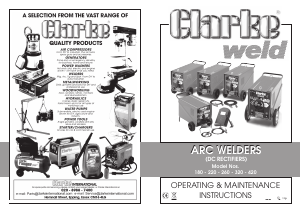


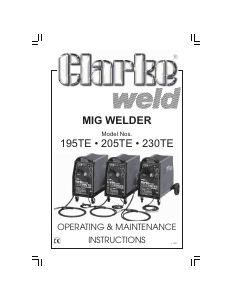
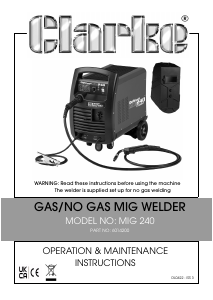
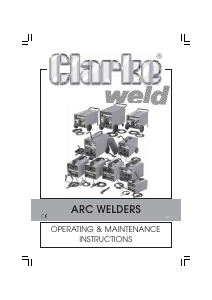
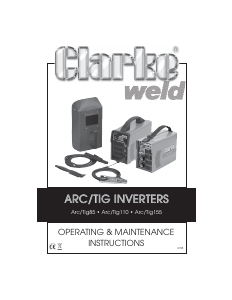
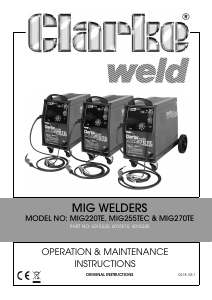
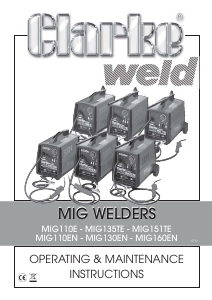
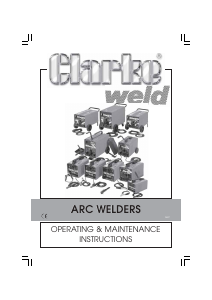
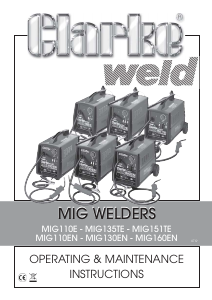
Join the conversation about this product
Here you can share what you think about the Clarke 180 Welder. If you have a question, first carefully read the manual. Requesting a manual can be done by using our contact form.